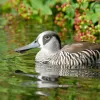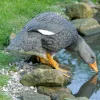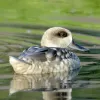
Long-tailed duck (Clangula hyemalis)
Species name
- Dutch name:
- IJseend
- English name:
- Long-tailed duck
- German name:
- Eisente
- French name:
- Harelde kakawi
- Scientific name:
- Clangula hyemalis
Scientific classification
- Order:
- Anseriformes
- Family:
- Anatidae
- Onderfamilie:
- Merginae
- Genus:
- Clangula
Description
- Description:
Exceptionally complex sequences of at least 4 plumages in the course of year; these based on two molts, as in other wildfowl, but both molts interrupted and therefore producing additional plumage types. Some have suggested occurrence of three or even four molts a year. Certainly some feathers, e.g. scapulars and sides of head neck are molted three times in a year, but the rest of the head and breast are molted twice a year, while the remainder of the body feathers, together with wing and tail, are only molted once. Perhaps best described as four partial molts. Birds frequently in molt, and therefore also showing transitional plumages.
Male:
Elongated central tail feathers always present in all plumages, except during late summer molt. Flanks and belly always white or whitish .In summer (about July to September), head, neck and chest dark brown, with white patch around eye; back and scapulars brownish- black, edged with red brown; rump and center of tail black.
In winter (about November to April). Head, neck and chest dark white, with blackish brown patch from lower and rear ear converts to side of upper neck; scapulars white; remainder of plumage as summer. In spring (around May to June), head becomes dark, while, in post breeding period ( September-November), head and neck become whiter and scapulars shorter. In flight, all dark wings contrast with white belly and sides. Bill black, with a broad pink band between tip and nostrils. Legs and feet blue-grey.Female:
Tail pointed, but without extended central feathers. In summer ( about May to August ), brown head, chest and upperparts, with whitish eye-ring and thin eye stripe; whitish around base of neck. White flanks and underparts. Progressively more white appears on head through autumn and into winter (from November), but crown remains blackish brown; blackish sides to head, neck and chest dark white, with blackish brown patch from lower and rear ear converts to side of upper neck. In flight, all dark wings contrast with white belly and sides. Bill, Legs and feet blue-grey.Juvenile:
Duller on upperparts and variably whitish on head and neck. Becoming whiter through winter. Male starts to show first winter but, full adult plumage 2nd winter.
- Behaviour:
Long-tailed Ducks dive and swim under water, and, while they propel themselves with their feet like other ducks, their wings are sometimes partly opened under water. Most feeding is done within 30 feet of the surface, but they are capable of diving more than 200 feet below the surface. Long-tailed Ducks fly low with stiff and shallow wing-beats, often tilting from side to side.
Standard Measurements
- Body Length (cm):
- The male (drake) of the Long-tailed duck measures approximately 44-60 centimeters. The female measures approximately 44-60 centimeters.
- Body Weight (grams):
- The male will weight about 740 gram. The female will weight about 740 gram.
The weight is notoriously variable and can only be used as indication!
- Habitat:
A Long-tailed ducks require clean, fresh, deep water, with at least 50% of the area greater than 80cm minimum, preferably one meter.
- Note:
The nest is located on dry ground close to the water, often hidden in the undergrowth or among rocks. It is a depression lined with plant material and great quantities of down that the female adds to the nest after she begins laying.
Take the following recommendations into account:
Long-tailed ducks should be fed with high quality seaduck pellets, provided in hoppers at water level so that the ducks can feed from the water. Feeding stations requiring the ducks to come ashore to feed are not recommended. The diet should be supplemented with fish or shrimp from April to May or June (eggs are normally laid end of May to June) and from August to September.
Nesting areas on islands and peninsulas should be provided, with very good ground cover such as long grass and ferns sufficient to provide a canopy over the nest. Egg collection may be started once the second egg has been laid, replacing the eggs with very accurate dummy eggs and storing the eggs in a sand tray prior to setting under a broody hen. Eggs may be moved to an incubator at 17 or 18 days and to a very high humidity hatcher for hatching.
Long-tailed duck ducklings are difficult to rear. Hand rearing under infra-red lamps for heat is suggested. Two factors appear to be particularly important in rearing ducklings: getting them to feed and getting them onto water at an early age.
It is suggested that they must be on water with sufficient depth for diving (minimum of 25cm deep) by four days old, and they must be eating well by this time. A very high protein starter crumb (35% or higher protein) with a very small particle size is suggested; If necessary a little feed may be placed on water containing gammarids (freshwater shrimps) whose movement stimulates feeding behaviour. New seaduck diets developed by Lundi in Germany, including a very small floating starter pellet are useful.
By ten days old, the ducklings can be outside with access to a deep pond, but with warmth provided by heat lamps. Concrete ponds may be used at this stage, although natural ponds are preferable.
- Breeding:
- The female Long-tailed duck usually lays from 6-11 cream-white eggs and incubates them for 24-29 days.
- Artificial incubating:
The ideal relative humidity for incubating most waterfowl eggs is 55% (ground nesters) and 40% (cavity nesters). The temperature is usually 37.4°C. Set ventilation as recommended by the incubator manufacturer. Eggs must be turned, either automatically or by hand, a minimum of 4 times a day. As the duckling develops there is a loss of water from the egg and the air sac gets bigger. In normal development of an egg with a 24-29 days incubation, the air sac occupies about a third of it three days earlier. Cleanliness is vital and ideally eggs should be moved to a separate hatcher at this point, where the humidity should be increased to 65% and even higher once they have pipped internally.
- Bird banding:
- Recommended closed leg band ring size for the Long-tailed duck is 9 mm.The leg band ring can only be applied on a young medium-sized sea duck at around 12 days old.
- It doesn't matter what leg that you band, but it's good to have a consistent system. Suggested: Left leg = Female, Right leg = Male
- Rearingfeed:
-




The best floatable special rearing feed from Lundi. This ideally balanced complete feed with 42% protein forms the perfect basis for the successful rearing of your ducks. The ducks grow well and have their perfect juvenile plumage after a short time.
Made exclusively from wholesome and selected raw materials, Lundi Micro 45 is also ideally suited for year-round feeding of waterfowl.
- Maintenance food:
-







Floatable special complete food for sea birds with the highest nutritional requirements. Each chunk contains the complete nutrient spectrum. The high protein content of 35% ensures a healthy and species-appropriate diet. Spiral algae give a more magnificent coloration of plumage and sea salt promotes the salt gland.




Floating special complete food for sea birds with the highest nutritional requirements thanks to a particularly high protein content of 45%.
Ideal for daily feeding in animals that eat a lot of protein in their natural habitat. A must for "fish eaters".
- Regulation:
- Europese soort
- Regulation:
The long-tailed duck is one of the species to which the Agreement on the Conservation of African-Eurasian Migratory Waterbirds (AEWA) applies.




